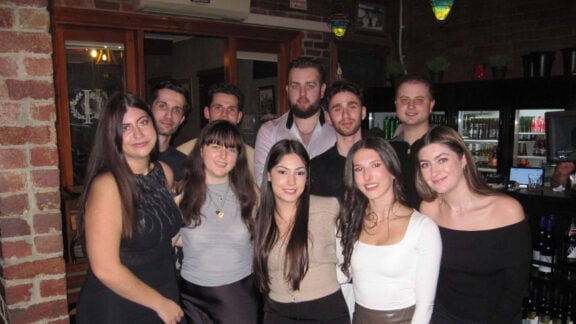Kostas Mavrikis says that the pirate Nikolaos Draciotis from the Aegean Island of Alonnisos arrived in Sydney as a prisoner in 1812.
Mavrikis, author and founder of the Alonnisos Museum, who lives and works on the island, will visit Australia in March and April.
The writer specialises in the history of the first Greek convict immigrants to Australia in the 1800s and Australian soldiers in Greece during the First and Second World Wars.
“In Australia I will be talking on my three historical books in Greek, with English (translations completed or pending) about the Greek family of Drakioti.”
The first book, The Pirate Nikolaos Drakiotis (Greek edition), is about a Greek pirate from Alonnisos who arrived in Sydney as a convict in 1812.
“The capture of Drakiotis by the British fleet and, after being taken first to Malta and Gibraltar, ending up in Australia finally is a true story.
“He was captured in 1812 and convicted of piracy, being a crew member of a Greek ship that set sail from the Black Sea carrying grain bound for Bonaparte’s France and Spain.

“Whoever broke the British embargo could make huge profits. From one trip, you could become wealthy. I discovered a letter from Drakiotis to his family, in which he described his adventure in Australia, and that’s how I learned about him,” said Mavrikis.
From Gallipoli to Tobruk: The Drakiotis family legacy in war
The second book, The Promise, in Greek and English, concerns the great-grandson of Drakiotis, who joined the ANZACS in Greece to fight in the Gallipoli campaign and witnessed the Armenian genocide in World War I.
Alexander Drakiotis participated in the Gallipoli Campaign, one of the Allies’ most significant failures of World War I, which coincided with the climax of the Armenian Genocide.
Drakiotis ended up in a Turkish prison but escaped only to witness and experience first-hand the unspeakable barbarities committed by the Ottomans against the Armenians.
The third book, Wanderer in Greek, is about the son of the great-grandson who fights in Tobruk with the Australian Division “and arrives in Greece as a saboteur during World War II.”

Preserving history: Alonnisos museum and cultural heritage
Mavrikis is also building an ANZAC Museum in Alonnisos, which is unique to Greece.
He also seeks to make his books into films or television series.
“My book on the ANZACS and the island of Peristera is being adapted and produced as a TV series,” he says.
Mavrikis was born and raised in Steni Vala by a family of fishermen with origins in Ikaria. From a young age, he was involved in underwater fishing and diving with his father.
They were the first to discover the world’s only shipwrecks of Peristera and sought to preserve them, and today, they are in the final stages of being opened as an underwater museum. Nothing would have happened if it hadn’t been for the persistence of these two. With the same tenacity, he began collecting objects from the sea and land.

At a young age, he decided to build his museum. At first, no one believed him, but he persevered. Today, after 18 years of operation, more than 900 m2 of building is needed to house the collections of 40,000 objects that Mavrikis collected. The impressive stone building dominates the harbour of Patitiri.
The museum is a centre of living culture, not a cold place with inanimate objects. The basement is the folklore section. It is a model village with tiny houses that house lost professionals. The naval section with Alonnisos is on the first floor from the 17th to the 19th century. Here, the sailors’ uniforms, their armaments, the objects they had on their boats, and the objects they brought back to their island to decorate their houses are exhibited. In the same room are also their wives with their respective costumes and personal belongings.

On the second floor is the pirate section, which depicts the pirate activity on the island of Alonnisos. The island was also called Kleptofoleai or Diavolonisia for many years due to the intense pirate presence.
The military section of the museum is housed on the same floor. The building also has a multi-purpose event hall, where exhibitions, mainly of young artists, speeches and small conferences Headline: Greek Author and Museum Founder to Promote Historical Books in Australia
On the top floor is the small café with endless discussions and the offices that coordinate its organisation. It is home to the Friends of the Museum, which supports the museum morally and by providing volunteer work.

Mavrikis has managed to gather a fantastic archive of 63,000 digital photographs from the area of the Northern Sporades, as well as a considerable volume of documents from 1700 to the present day (the archive contains about 30,000 documents). He is passionate about preserving objects and documents that he alone has managed to save an essential part of the history of the Northern Sporades.
Mavrikis has written 12 books about the islands has also created the Archive of Studies of Alonnisss and Desert Islands with three publications. When someone asks why he does not promote all this, he says he did it all “out of love for the island and its inhabitants and to fill the existing cultural gaps.”









